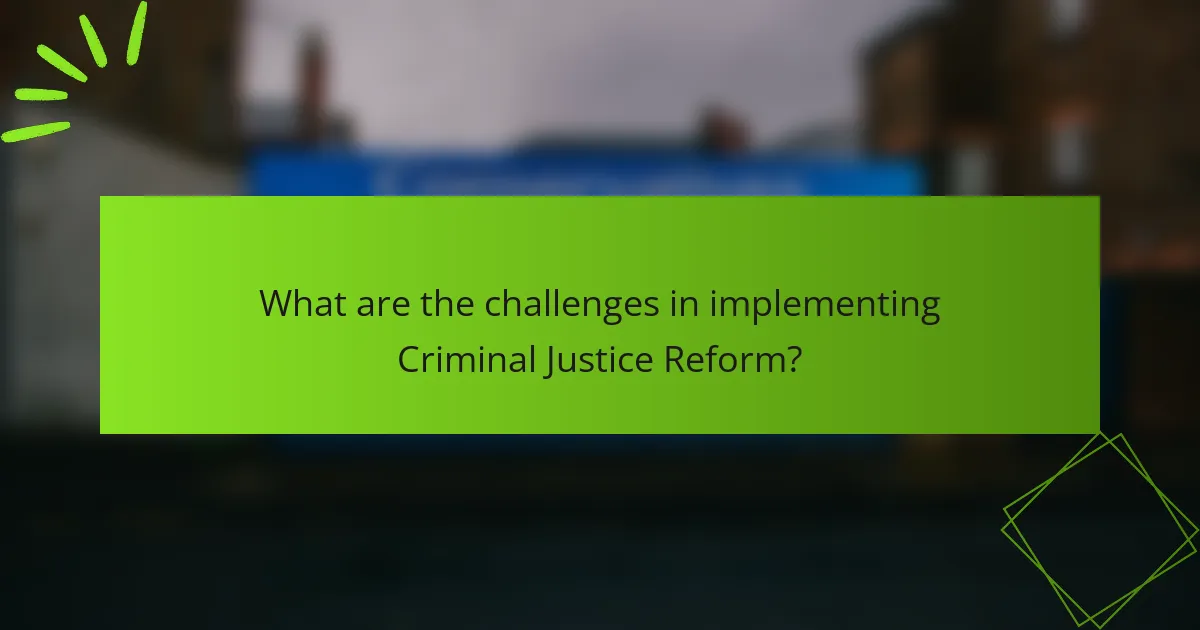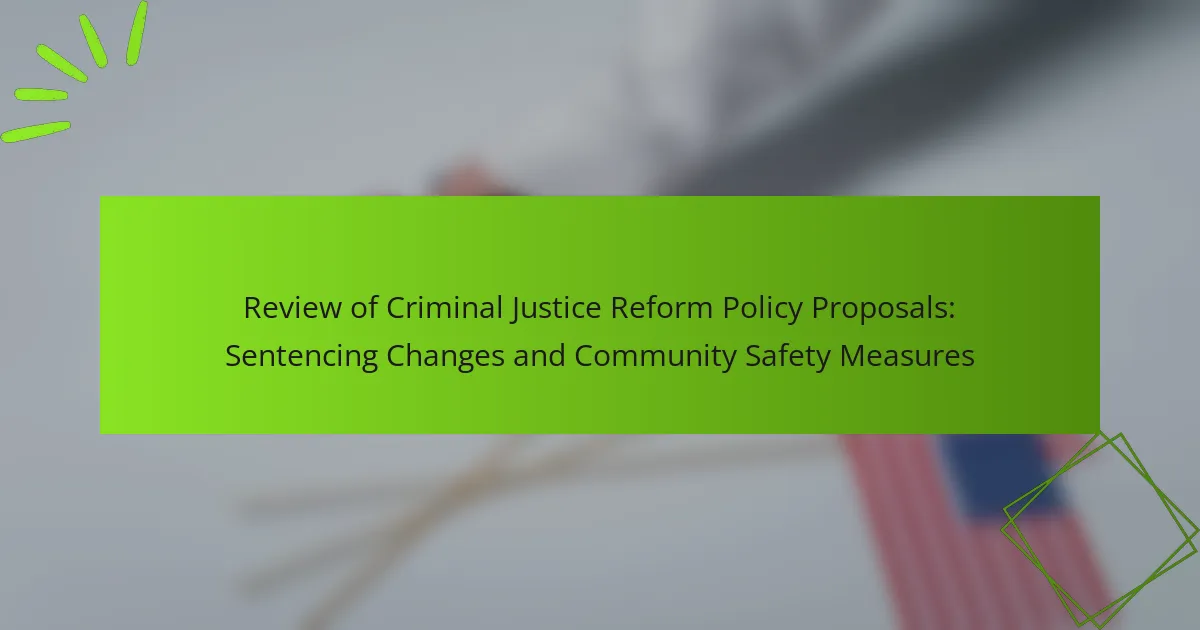Criminal justice reform policy proposals aim to address systemic issues within the justice system through key elements such as sentencing reform, diversion programs, and police accountability measures. These proposals focus on reducing mandatory minimum sentences, redirecting offenders to rehabilitation instead of incarceration, and enhancing transparency and oversight in law enforcement. Research indicates that these reforms can lead to decreased incarceration rates, improved community safety, and enhanced racial equity. However, challenges such as resistance from law enforcement, political opposition, funding limitations, and public perception can impede the implementation of meaningful reform. Overall, the article examines the potential benefits and obstacles associated with criminal justice reform initiatives.

What are the key elements of Criminal Justice Reform Policy Proposals?
Key elements of Criminal Justice Reform Policy Proposals include sentencing reform, diversion programs, and police accountability measures. Sentencing reform aims to reduce mandatory minimums and eliminate harsh penalties for non-violent offenses. Diversion programs seek to redirect offenders away from incarceration and into rehabilitation. Police accountability measures focus on transparency, oversight, and the implementation of body cameras. These proposals often advocate for community-based alternatives to incarceration. Research shows that such reforms can lead to lower recidivism rates and safer communities. For instance, a study by the Brennan Center for Justice highlights the positive impact of diversion programs on community safety.
How do sentencing changes impact the criminal justice system?
Sentencing changes significantly impact the criminal justice system by altering how offenders are punished. These changes can lead to reduced prison populations, as alternative sentencing options may be implemented. For example, jurisdictions that adopt restorative justice practices often see a decrease in incarceration rates.
Additionally, sentencing reforms can affect recidivism rates. Research indicates that rehabilitative approaches, such as community service or drug treatment programs, can lower the likelihood of reoffending. A 2017 study by the National Institute of Justice found that offenders who participated in such programs had a 30% lower recidivism rate compared to those who received traditional sentences.
Moreover, changes in sentencing laws can influence public perception of fairness in the criminal justice system. When sentencing disparities are addressed, communities may experience increased trust in law enforcement. This trust can lead to better cooperation between the public and law enforcement agencies, enhancing community safety.
Overall, sentencing changes reshape the criminal justice landscape by promoting rehabilitation, reducing incarceration, and fostering community trust.
What are the different types of sentencing changes proposed?
Different types of sentencing changes proposed include reduced mandatory minimum sentences, expanded use of parole, and alternatives to incarceration. Reduced mandatory minimum sentences aim to provide judges with more discretion in sentencing. This allows for consideration of individual circumstances in each case. Expanded use of parole can facilitate earlier release for non-violent offenders. It helps reduce prison overcrowding and promotes rehabilitation. Alternatives to incarceration, such as restorative justice programs, focus on rehabilitation rather than punishment. These changes are often proposed to address issues of fairness and effectiveness in the criminal justice system. Recent studies indicate that such reforms can lead to decreased recidivism rates and improved community safety.
How do these changes affect recidivism rates?
Changes in criminal justice reform policies, such as sentencing alterations and community safety measures, can significantly affect recidivism rates. Studies show that implementing alternatives to incarceration, like rehabilitation programs, reduces repeat offenses. For instance, a study by the National Institute of Justice found that participants in diversion programs had a 10-15% lower recidivism rate compared to those who were incarcerated. Additionally, community-based interventions, such as job training and mental health services, have been linked to lower rates of reoffending. Overall, these changes promote rehabilitation over punishment, leading to decreased recidivism rates.
What community safety measures are part of reform proposals?
Community safety measures in reform proposals often include enhanced mental health services. These services aim to address the root causes of criminal behavior. Increased funding for community policing is another measure. This approach fosters better relationships between law enforcement and community members. Programs for violence prevention, such as conflict resolution training, are also proposed. These programs aim to reduce incidents before they escalate. Additionally, reforms may include the establishment of community oversight boards. These boards provide a platform for accountability in policing practices. Investment in youth programs is frequently highlighted as well. These programs offer constructive alternatives to at-risk youth. Together, these measures aim to create safer communities while promoting justice reform.
How do community safety measures differ from traditional law enforcement approaches?
Community safety measures focus on prevention and community involvement, while traditional law enforcement emphasizes enforcement and punishment. Community safety initiatives often include programs like neighborhood watch and community policing. These programs encourage collaboration between citizens and law enforcement. They aim to address root causes of crime through social services and education. Traditional law enforcement relies heavily on police presence and legal consequences. It often responds reactively to criminal activities rather than proactively preventing them. Research indicates that community-based approaches can reduce crime rates and improve public trust. For example, a study by the Urban Institute found that community policing strategies led to a 10% decrease in crime in participating neighborhoods.
What evidence supports the effectiveness of these measures?
Research indicates that criminal justice reform measures, such as sentencing changes and community safety initiatives, can effectively reduce recidivism rates. A study by the Brennan Center for Justice found that states implementing these reforms saw a 20% decrease in re-offense rates. Additionally, community safety measures, like restorative justice programs, have shown a 30% reduction in crime rates in areas where they were adopted. Evidence from the National Institute of Justice supports that alternatives to incarceration lead to better outcomes for individuals and communities. Overall, data from various studies demonstrate that these measures contribute positively to public safety and reduce the burden on the criminal justice system.

What are the challenges in implementing Criminal Justice Reform?
Implementing Criminal Justice Reform faces several challenges. Resistance from law enforcement agencies often hinders progress. Many police departments are reluctant to change established practices. Additionally, political opposition can stall reform efforts. Some lawmakers prioritize public safety concerns over reform initiatives. Funding limitations also pose a significant barrier. Many proposed reforms require financial investment that is not readily available. Public perception can complicate implementation as well. Misinformation about reforms can lead to fear and opposition. Furthermore, systemic issues within the justice system may resist change. Deep-rooted biases and practices can be difficult to alter. These challenges collectively impede the advancement of meaningful reform.
Why is there resistance to sentencing changes?
Resistance to sentencing changes arises from concerns about public safety. Many believe that reducing sentences may lead to increased crime rates. Research indicates that longer sentences can deter criminal behavior. Additionally, some stakeholders fear that changes may disproportionately benefit offenders. Community members often express anxiety about the implications for their safety. Law enforcement agencies may oppose changes, citing the need for strict penalties. Political factors also play a role, as elected officials may hesitate to support reforms that could be unpopular with constituents. Overall, these factors contribute to a complex landscape of resistance to sentencing changes.
What are the concerns of law enforcement regarding these changes?
Law enforcement is concerned that changes in sentencing policies may lead to increased crime rates. They worry that reduced penalties for certain offenses will embolden offenders. This could result in a rise in repeat offenses. Additionally, law enforcement fears that community safety measures may not be adequately funded. Insufficient resources could hinder their ability to respond effectively to crime. There is also concern about the potential for misinterpretation of reform measures. Misunderstandings could lead to inconsistent enforcement of laws. These factors contribute to a general apprehension regarding the impact of reforms on public safety.
How do public perceptions influence reform efforts?
Public perceptions significantly influence reform efforts in criminal justice. When the public supports specific reforms, policymakers are more likely to implement them. For example, increased awareness of racial disparities in sentencing has led to calls for reforms. Studies show that public opinion can shape legislative agendas. In 2018, a survey found that 70% of respondents favored reducing mandatory minimum sentences. This strong public backing prompted legislative proposals aimed at sentencing changes. Conversely, negative public perceptions can hinder reform efforts. Fear of crime can lead to resistance against reducing penalties or implementing alternative measures. Overall, public sentiment serves as a critical driver for or against reform initiatives.
What obstacles do community safety measures face?
Community safety measures face several obstacles. Funding limitations hinder the implementation of effective programs. Many local governments struggle to allocate sufficient resources for safety initiatives. Additionally, community resistance can impede the acceptance of safety measures. Residents may fear increased surveillance or policing. Lack of coordination among agencies complicates the execution of safety strategies. Diverse community needs can lead to conflicting priorities. Furthermore, political opposition can undermine support for safety policies. These factors collectively challenge the effectiveness of community safety measures.
How do funding issues affect the implementation of these measures?
Funding issues significantly hinder the implementation of criminal justice reform measures. Insufficient financial resources limit the ability to develop and maintain programs. This includes community safety initiatives and alternative sentencing options. Lack of funding can lead to inadequate staffing and training for law enforcement and support services. Consequently, programs may fail to meet their intended goals. For example, a study by the Vera Institute of Justice found that jurisdictions with higher funding levels achieved better outcomes in community safety initiatives. Without adequate funding, reforms may be poorly executed or entirely abandoned. This creates a cycle of ineffective justice practices and community distrust.
What role do community stakeholders play in overcoming these obstacles?
Community stakeholders play a crucial role in overcoming obstacles in criminal justice reform. They provide local insights that shape effective policies. Their involvement fosters collaboration between law enforcement and the community. This collaboration enhances trust, which is vital for successful reform. Stakeholders, including advocacy groups, local leaders, and residents, can identify specific community needs. They also help to advocate for policies that prioritize safety and rehabilitation. Evidence shows that community engagement leads to more sustainable reform outcomes. For instance, initiatives in various cities have demonstrated reduced recidivism rates when stakeholders are actively involved.

What are the potential outcomes of Criminal Justice Reform Policy Proposals?
Criminal justice reform policy proposals can lead to reduced incarceration rates. These reforms often emphasize alternatives to imprisonment, such as community service or rehabilitation programs. Studies indicate that states implementing such reforms have seen significant decreases in prison populations. For instance, California’s realignment policy reduced its prison population by over 25,000 inmates from 2011 to 2017.
Additionally, reform proposals may improve community safety. Evidence shows that focusing on rehabilitation can lower recidivism rates. A meta-analysis by the Washington State Institute for Public Policy found that effective rehabilitation programs can reduce reoffending by up to 30%.
Moreover, criminal justice reforms can enhance racial equity. Many proposals aim to address systemic biases within the justice system. Research from the Brennan Center for Justice highlights that reforms like eliminating mandatory minimum sentences can disproportionately benefit marginalized communities.
Overall, the potential outcomes of criminal justice reform policy proposals include reduced incarceration rates, improved community safety, and enhanced racial equity.
How might sentencing changes improve community safety?
Sentencing changes can improve community safety by reducing recidivism rates. Research indicates that more rehabilitative approaches lead to lower re-offense rates. For example, programs focusing on education and job training have shown success in reintegrating offenders. A study by the National Institute of Justice found that inmates who participated in educational programs were 43% less likely to return to prison. Additionally, adjusting sentencing guidelines can prioritize non-violent offenders for alternatives to incarceration. This approach frees up resources for law enforcement and community programs. Ultimately, these changes foster a safer environment by addressing the root causes of crime.
What long-term effects can be expected from these reforms?
Long-term effects of these reforms may include reduced incarceration rates and improved community safety. Reforms can lead to a decrease in the prison population by emphasizing alternatives to incarceration. Studies, such as those from the Vera Institute of Justice, show that states implementing sentencing reforms have experienced significant drops in prison admissions. Additionally, community safety may improve as resources are redirected from incarceration to rehabilitation programs. Programs targeting mental health and substance abuse have proven effective in reducing recidivism rates. Research indicates that states with such reforms see lower crime rates over time. Overall, these reforms can foster a more equitable justice system while enhancing public safety.
How do these changes promote rehabilitation over punishment?
Changes in criminal justice reform promote rehabilitation over punishment by emphasizing restorative practices and support systems. These reforms often prioritize mental health treatment, education, and job training for offenders. By focusing on personal development, individuals are less likely to reoffend. Research shows that rehabilitation programs can reduce recidivism rates significantly. For example, studies indicate that participation in vocational training can lower reoffense rates by up to 30%. Additionally, community-based alternatives to incarceration foster reintegration into society. This approach helps build stronger community ties and support networks. Overall, these changes shift the focus from punitive measures to constructive, rehabilitative strategies.
What best practices can be adopted for successful implementation?
Successful implementation of criminal justice reform requires stakeholder engagement. Engaging law enforcement, community leaders, and advocacy groups ensures diverse perspectives. Clear communication of goals and processes is essential. Transparency fosters trust among stakeholders. Training and resources for law enforcement are crucial for effective policy adherence. Continuous assessment and feedback loops improve implementation strategies. Data-driven decision-making enhances accountability and effectiveness. Evidence from successful reforms shows that these practices lead to better community outcomes and reduced recidivism rates.
How can community involvement enhance the effectiveness of reforms?
Community involvement can enhance the effectiveness of reforms by fostering collaboration and trust between stakeholders. Engaging the community allows for diverse perspectives, which can lead to more comprehensive solutions. Research shows that reforms with community input are more likely to address the actual needs of the population. For example, the National Institute of Justice found that community engagement in criminal justice policy leads to greater public support and compliance. This support can result in smoother implementation of reforms. Furthermore, community involvement can help identify potential challenges early on, allowing for proactive adjustments. Overall, active participation from the community ensures that reforms are relevant and effective.
What strategies can be employed to measure the success of these proposals?
To measure the success of criminal justice reform policy proposals, specific strategies can be employed. These strategies include establishing clear, measurable objectives for each proposal. Data collection methods such as surveys, crime statistics, and recidivism rates are essential. Analyzing these data points over time provides insight into the effectiveness of the proposals. Engaging stakeholders, including community members and law enforcement, can offer qualitative assessments of changes. Regularly reviewing and adjusting policies based on findings ensures ongoing relevance and effectiveness. Studies, such as the one by the National Institute of Justice, highlight the importance of evidence-based practices in assessing reform outcomes.
The main entity of the article is Criminal Justice Reform Policy Proposals, which focus on sentencing changes and community safety measures. Key elements include sentencing reform aimed at reducing mandatory minimums, diversion programs to redirect offenders, and police accountability measures to enhance transparency. The article discusses the impact of these reforms on recidivism rates, community safety, and racial equity, while also addressing the challenges and resistance faced in implementing these changes. Evidence supporting the effectiveness of these proposals highlights their potential to create safer communities and promote rehabilitation over punishment.
